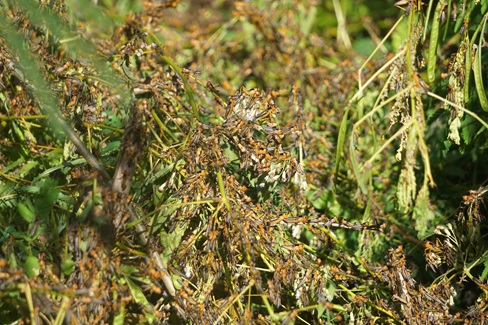The UGM Faculty of Agriculture, in collaboration with the Indonesian Ministry of Agriculture, FAO Indonesia, and the East Sumba Regional Government, orchestrated an evaluation and coordination effort to tackle the ongoing locust infestation on Sumba Island, East Nusa Tenggara.
The evaluation aimed to confront the locust invasion, which, since February 2023, has wreaked havoc on agricultural lands, posing a severe threat to the region’s food security.
The assessment unfolded at the East Sumba Regional Government Complex on Wednesday (Dec. 14), with representatives from the UGM Faculty of Agriculture, FAO Indonesia, the Directorate of Plant Protection at the Ministry of Agriculture, officials from four districts, district heads, and community leaders participating.
Professor Andi Trisyono, the head of the UGM team, emphasized that the East Sumba Regional Government, in collaboration with UGM, the Ministry of Agriculture, and FAO, executed coordinated locust control measures commencing on Feb. 6, 2023.
The comprehensive approach included mapping the locusts’ location, population, and phase, followed by control efforts encompassing capturing and spraying identified locust hotspots.
Subsequently, an evaluation was conducted to gauge the effectiveness of the applied control technology in curbing the locust population, coupled with ongoing monitoring and surveillance.
“This systematic approach, comprising these four activities, should serve as the foundation for locust management on Sumba Island. This ensures the early detection of pest population development, facilitating immediate intervention to avert a major outbreak on Sumba Island in the coming years,” he elucidated.
Professor Trisyono highlighted that the collaborative efforts across multiple stakeholders have notably reduced the locust population. Initially standing at 24 billion in February 2023, the population dwindled to 15 million by November 2023. A synergistic collaboration, structured, scheduled monitoring, and prompt intervention emerged as the linchpin for successful mitigation.
The locust outbreak on Sumba Island dates back to 2019. Professor Trisyono noted that a significant factor contributing to the locust surge is the decline in the population of natural adversaries, including both predators and parasitoids. The diminished numbers of these natural enemies compromise their ability to control population development effectively.
“While control activities have been in place since the pest outbreak in 2019, involving capture, extermination, and the use of insecticides, the pest has persisted in a sizable population, particularly surging around the onset of the rainy season (November) and peaking from February to April,” he explained.
Professor Trisyono stressed that while capturing locusts and utilizing insecticides provide short-term relief by swiftly reducing the population and mitigating losses, the quest for more environmentally friendly control technologies becomes imperative for medium and long-term purposes.
“The presence of natural enemies such as birds and predatory insects is crucial in maintaining the locust population at a manageable level in the solitary phase on Sumba Island,” he emphasized.
Moreover, Professor Trisyono highlighted the abundance of bird species in East Sumba Regency, some of which are natural locust predators. However, their population remains scant, necessitating efforts to protect, preserve, and augment the numbers of indigenous predatory birds on Sumba Island.
Concurrently, research into the efficacy of entomopathogens is underway, potentially offering a more environmentally friendly alternative to synthetic chemical insecticides for locust control.
Author: Ika




